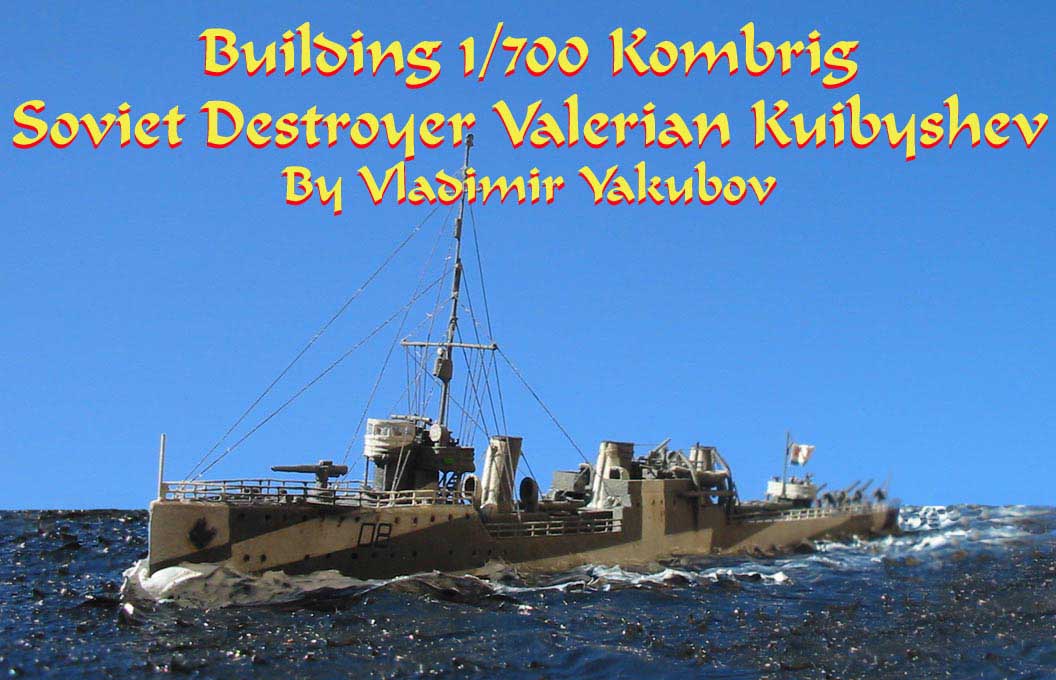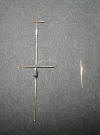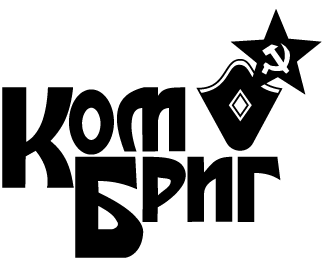Building Kombrig's 1/700 Destroyer
Valerian Kuibyshev
in its 1943 fit
by Vladimir Yakubov
In 1911 Imperial Russian Navy laid down a large destroyer that proved to be as revolutionary for WWI as US Fletcher class DDs were for WWII. In 1913 that destroyer - named Novik - was commissioned. It was the fastest and most heavily armed destroyer in the world. Novik was armed with four very powerful 4"/60 and eight 18" torpedo tubes and reached 37 knots on trials - making it the fastest warship in the world at the time. Russian navy immediately realized the excellent warship that they had on their hands and between 1912 and 1915 no less than 53 destroyers based on Novik were laid down. They were not copies of Novik but were laid down in seven series that had slight differences in dimensions, speed and armament.
On of these destroyers was a Series III Novik type, also known as Gavriil class, destroyer Kapitan Kern. The ship displaced 1260 tons, was armed with four 4"/60 guns and three triple 18" torpedo tubes and had a top speed of 32 knots. It was laid down in St.Petersburg at the Putilov factory on 21 November 1913. Work progressed pretty fast and the ship was launched in August 1915. However Russia lagged in the manufacture of high speed turbines which were often ordered overseas (some of which were ordered in Germany and actually went on to power German half-copies of Novik class - V97 class) and with the war many of then were delayed or not delivered at all, which caused the work on many of the new ships to stop. Unfortunately the same fate awaited Kapitan Kern. The work on it stopped and it was abandoned in the fitting out basin.
The ship got new life when in 1925 it was inspected by the new Soviet government and found that the hull was sound and could be finished to fill out the ranks of growing Soviet Navy. At the same time the ship got its new name Valerian Kuibyshev - a political leader of the Red army and one the important ministers in the Soviet Government. The ship was finally commissioned in 1927. In 1933 it was transferred to the newly created Northern Fleet and was periodically refitted.
The ship started WWII in the North and was very active from the first day - laying mines and shelling advancing German troops. It was very active in escorting convoys but due to its short range could not escort them all the way to England (its range was only 1720nm at 16 knots), so most of the escort missions involved taking over escort from the allied warship close to Murmansk. During one such mission in February 1942 a close explosion of the mine damaged the ship, so that it spent next three months being repaired. In June 1942 it took part in the fruitless rescue attempts of convoy PQ-17 (which lost 23 ships out of 36 that set out for Murmansk). In November 1942 Kuibyshev took part in the rescue of the crew of destroyer Sokrushitel'nyi which broke up in the storm. In terrible weather 176 people were rescued by Kuibyshev. In August - September 1943 the ship was refitted with sonar and and extra AA guns. By that time the ship's displacement reached 2020 tons, while max speed dropped to 28 knots. Anti-Aircraft armament was increased to two 45mm/68 21-KM guns, two 37mm 70-K guns, two 20mm Oerlikons and three 12.7mm DShK machine guns. The ship had very active war escorting both Soviet and Allied convoys until almost the last day of the war. During the war the ship shot down several German aircraft and attacked several German U-boats, through now were confirmed sunk by it.
The veteran ship continued to serve until 1955 when it was converted to a test ship and was scrapped in 1956.
The Kit
One of the latest Kombrig releases, WWII Kuibyshev has 42 excellent resin parts. As customary with Kombrig the small details are nearly flawless. Guns, ship's boats, bridges and ventilators are flawlessly cast with very little flash and no air bubbles. Unfortunately the hull is pretty badly disproportioned for such a distinctive ship. On the right you can see the comparison of the hulls Kuibyshev's WWI sister ship Azard and Kuibyshev as corrected to fit the plans (which were actually provided with the kit, which surprised me since it show that they had correct plans). There were two main problems with hull. While the length was correct, the problem is that it was 1.5mm too short in front of the forward superstructure and 1.5mm to long at the stern. The second problem is that the hull is 2mm too wide in the middle. It starts from the step behind the forecastle and goes all the way to the stern. While 2mm would not be very noticeable on a battleship, on a slim long hull of a destroyer it is very visible. Overall the kit is OK, since the hull problems while annoying are relatively easy to solve for anyone with moderate skills.
click images
to enlarge
Construction
The Hull
As pointed out above the hull was the biggest problem in the kit. To solve the profile problems I cut off the bow just in front of the forward superstructure and inserted about 1.5mm thick piece of styrene in between the pieces. This gave the nose the correct length and made the superstructure seem more proportional with the rest of the hull. Now however the ship was about 1.5mm too long. Fortunately that length came straight out of the stern and after shaving it the profile of the ship was just right. That left us the problem of extra width. In real life the ship was 9.34m wide, however the kit scales out to 10.5m wide, which on a long slim hull of a destroyer is really noticeable. To cure this problem, I took a Dremel tool and shaved about 1mm from either side of the ship starting from the end of the forecastle to the stern of the ship. After sanding the hull and using the putty to fill in the dents left by Dremel, the hull was nearly ready to go. The long thin superstructure sides in the middle of the hull were sanded down during the thinning of the hull, but were built up again using 1mm styrene glued from the inside. The forward gun platform was about 1mm to wide so I shaved a little off both sides. The bridge was cast integral with the conning tower, but was a bit too small, plus in real life it was open from the back, so I took it off and decided to scratchbuild it. It this point I added smoke stacks and PE doors as I usually do before painting and was ready to paint.
I chose to do the ship as it appeared in mid 1943, since I had a relatively clear photo of the ship in that camouflage scheme and I really liked it. At the time, the ship was camouflaged in dark grey and white (or very light gray) splinter camouflage. I saw a similar undated photo of the opposite side of the ship carrying identical camouflage, so I decided to paint both sides of the ship with nearly identical camouflage. I first painted the deck and the sides dark grey and then drew the camouflage scheme on a profile of the ship scaled to the need size and using that drawing cut out the necessary patterns from masking tape. Once all the pattern was masked I sprayed it with white, but I deliberately didn't completely clean the airbrush before doing it, so the white came out looking dingy, uneven and dull. After necessary touchups I covered the ship with Black-It-Out a water soluble ink-like liquid to do the shading. After it dried I wiped it off with Q-tip and stiff brush leaving it in the recesses to add texture. As a final step I dry-brushed the hull and touched up where necessary and was finally ready to add small details.
Photo from "Entsiklopedia Sovetskih Nadvodnyh Korabley 1941-45" (Encyclopedia of Soviet Surface ships 1941-45) by A.V. Platonov
Details
First thing I did was to add the bridges as I always do. I decided to scratchbuild the forward bridge since the kit bridge was too small and the bridge was open from the back. The bridge sides were made from canvas covered railings, so to simulate it I installed the railings and then I filled the spaces between them with thinned down white glue. Once it dried it settled in between the railings forming a textured surface that looks just like railings with sagging canvas over them. It is slightly exaggerated, but looks OK once drybrushed. Then to make the bridge windows I took piece 1/350 scale ladder and bent it to shape and glued on top of the railing. I scratchbuilt the bridge instruments and the roof. All of the bridges had solid splinter shields around them, but in real life the bridges were framed with canvas covered railings, so I cut off the splinter shielding and clued the railings and used the same while glue to simulate the canvas. In the amidships superstructure there were solid splinter shields that were present on the real ship, but since the hull was narrowed the boat deck also had to be cut down, which destroyed the shields. I scratchbuilt them using Alps printer paper, which has the consistency of plastic and is about the same thickness as 0.005 plastic, but is stronger and easier to work with. I use it whenever I need to simulate photo etch. In building the model I used WEM and Tom's Modelworks photo etch.
Armament
Next big step was the armament. While the ship was old, it was literally covered with weapons. The kit included four very nicely molded 4" guns one 3" AA gun and four 37mm AA gun. The 3" gun would be useful if the ship would be built in its 1927 to 1940 fit, but it was removed in 1941. Kombrig's instructions say that in 1944 the ship carried four 37mm guns, and it is very possible that it was true (the information on Noviks in their WWII fits is extremely limited), but the sources that I have give the armament of two 45mm guns, two 37mm guns and two 20mm guns and three 12.7mm DShK machine guns was carried from 1943 to 1944. I used kits two 37mm guns. Two 45mm guns were not present in the kit, so I scratchbuilt two of them using brass rod and gun shields made from Alps paper. 20mm guns came from Tom's Modelworks set. 12.7mm guns came from modified German 20mm guns from WEM set. The stern of the ship is extremely cluttered with guns (eight guns of four different calibers in the space of 25 meters), so the only way for the 4" guns to fit was for them to be elevated over each other and other guns, so I cut them just above the base and re-glued them at elevated position. Three triple 18" torpedo launchers were well cast but very plain with no surface detail, so I detailed them with stretched sprue, which made them come alive. When installing torpedo launchers be careful since Kombrig drawings show them all facing backwards, but the photos that I have show the forward mount facing backwards and aft mounts facing forward, so consult your references.
Masts
Masts presented a problem, since of the three photographs that I have of the ship in WWII two don't show the aft mast and one that might (see the photo on this page) but is of very bad quality and is hard to tell. Since I was using that photo and Kombrig's plans showed it I decided to add it to my model. The platforms on the forward mast in Kombrig's plans did not correspond to the photo, so I went with the photo for my scratchbuilding. Masts were scratchbuilt from brass rod and I used pantyhose threads for rigging. I used a Soviet flag from Duane Fowler.





Once everything was finished I weathered the ship with pastels and drybrushing. This toned down the white stripes even more and made the ship look used. However the available references show that Soviet ships didn't look very weathered, so I kept the weathering toned down. After everything was finished I sprayed the whole model with Model Master Dullcote to cover all of the glue spots. After Dullcote dried I used Micro Kristal Klear to glaze in the windows on the bridge and the illuminators in the hull as a very last step.





This kit fills a big void in the kits of the Russian/Soviet destroyers and if you are interested in either WWI or WWII Russian Destroyers I would recommend this kit. Unfortunately if build as is, the proportions of the hull would make the ship look subtly wrong, so I recommend you fix the hull problems if you build the kit. The small details are well done, some of the AA guns are missing but are easily replaced with PE aftermarket products. Overall I would recommend this kit to any experienced modeler who is interested in WWII DDs or Russian/Soviet ships.
© ModelWarships.com






